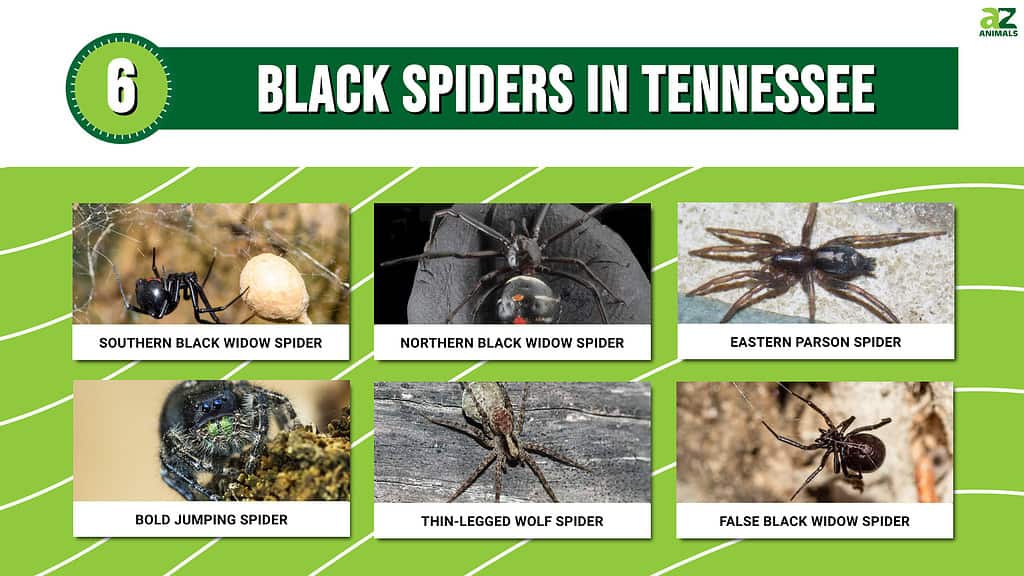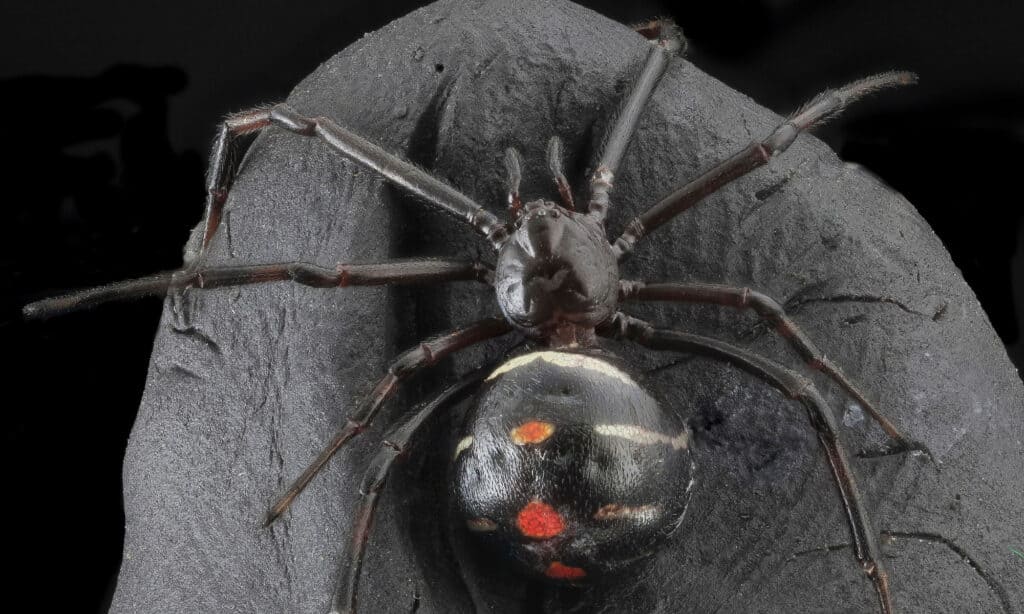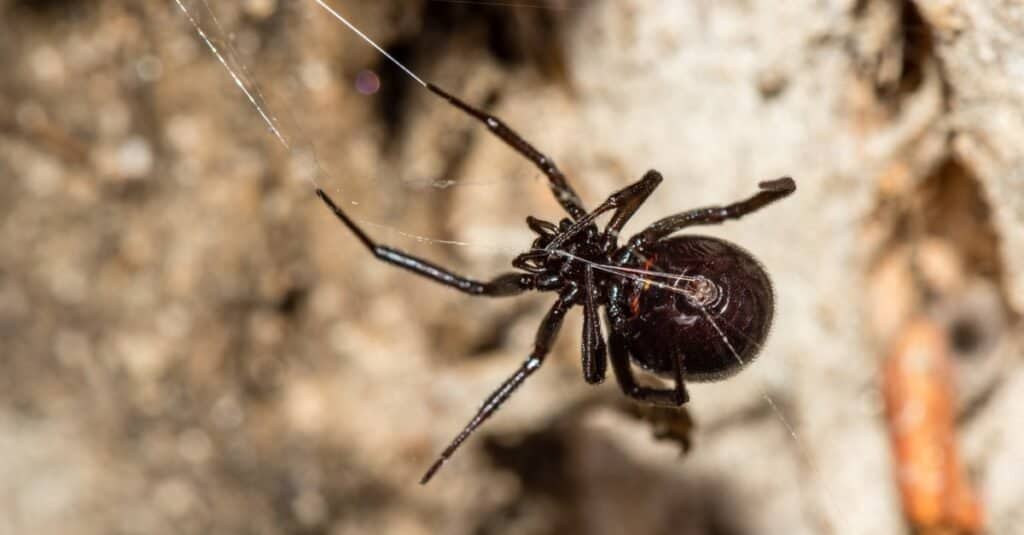Tennessee is home to around 40 to 50 different types of spiders, with a few of these spiders having a black coloration. Black widows and their lookalikes seem to be the most common type of black spider in Tennessee, which can be unfortunate for many. Most of the spiders we have listed do have medically significant venom, which is why you should take caution when identifying and handling any spiders you come across. To help you identify these spiders, here’s an overview chart:

Read on for more detail about the 6 black spiders you are likely to come across in Tennessee:
1. Southern Black Widow

The adult female spider has medically significant venom, meaning the bite and venom from this spider can harm humans.
©Jeff W. Jarrett/Shutterstock.com
The feared southern black widow spider (Latrodectus mactans) is a venomous member of the Latrodectus genus. The adult female spider has medically significant venom, meaning the bite and venom from this spider can harm humans.
The female southern black widow has an entirely black body, except for the distinctive red hourglass marking on their round abdomen. Whereas males are more colorful with an elongated abdomen and hourglass marking with orange and yellow. Male or juvenile southern black widows do not have medically significant venom, but it is still a good idea to be cautious around them.
Southern black widows grow to around 0.5 inches in size, with males only being half the size. This makes the female southern black widow easily identifiable, but it is not uncommon to misidentify them as a false black widow.
The southern black widow resides in dark places, usually in basements, behind furniture, or outdoors in piles of wood or tree stumps. Here they create an intricate web and feed off small insects such as flies or ants.
2. Northern Black Widow

The most distinctive difference between the northern and southern black widow is that the northern black widow does not have hourglass markings on their abdomens.
©Porco_Rosso/Shutterstock.com
The venomous northern black widow (Latrodectus variolus) is closely related to the southern black widow. Both spiders belong to the same genus of venomous spiders. They are mainly found in the northern parts of the United States, but they are found in Tennessee.
The most distinctive difference between the northern and southern black widow is that the northern black widow does not have hourglass markings on their abdomens. Instead, they have a red pattern broken up into different parts on their abdomen. It can look like a mixture of either lines or dots.
The female northern black widow is the one with the black coloration. Males are usually a brownish color with more colorful abdomen patterns ranging in colors from orange, white, and red. The male is half the size of the female, who has a size of 0.6 inches, excluding their leg span.
Northern black spiders create a dimensional web in dark areas, such as basements, and garages, and outdoor areas such as tree branches. The females do have a medically significant bite, so medical treatment is necessary if you have been bitten.
3. Eastern Parson Spider

This spider does not have medically significant venom, although their bite can be temporarily painful and trigger allergies in certain people.
©Fyn Kynd from Searsmont, Maine, United States / CC BY 2.0, via Wikimedia Commons – License
The arguably creepy yet fascinating eastern parson spider (Herpyllus Ecclesiasticus) is a type of hunting spider that is commonly found in Tennessee and other parts of the United States. This spider does not have medically significant venom. Although, their bite can be temporarily painful and trigger allergies in certain people. You are likely to get bitten if you disturb this spider, as they are quick to bite out of defense.
Eastern Parson spiders range in size from 0.4 to 0.8 inches in size, with females being larger than males. The female eastern Parson spider has a brownish-black coloration with grey marking on the abdomen, cephalothorax, and parts of the spider’s legs. Both genders have reddish-brown marking on their bodies with short hairs.
These spiders can be found both indoors and outdoors, seeming to take a preference to our homes during winter. In an outdoor environment, you can find this spider under leaves, branches, and wood piles, while in warm and dark areas of your home. They are most active at night when they hunt for their prey which includes insects.
4. Bold Jumping Spider

As the name suggests, these spiders are known for their ability to jump an impressive distance when they are catching their prey and moving around.
©Mircea Costina/Shutterstock.com
The adorable bold jumping spider (Phidippus audax) is a type of jumping spider found in Tennessee that is commonly kept as a pet. As the name suggests, these spiders are known for their ability to jump an impressive distance when they are catching their prey and moving around. Instead of building a web, the bold-jumping spider will jump onto their prey with lightning speed.
You can identify a bold jumping spider by their predominantly black and brown hairy body with big eyes and whiteish-green or blue markings. They only reach a size of 0.3 to 0.5 inches, with males being slightly smaller. Bold jumping spiders have a distinctive white triangle on their abdomen. It is identifiable when you look closely at their abdomen.
The bite of a bold jumping spider is not a cause for concern. Their venom is reserved for their prey. However, the bite may be slightly uncomfortable. You are most likely to get bitten by this spider from rough handling, where they may bite out of defense.
Bold jumping spiders are carnivores and ambush hunters, who feed on small insects. You can find them as pets in the pet trade industry, or in the wild.
5. Thin-Legged Wolf Spider

Thin-legged
wolf spiders
do not have medically significant venom, but their bite can be slightly painful and cause minor discomfort.
©Maksim Miasnikou/Shutterstock.com
The thin-legged wolf spider (Pardosa spp.) is a genus of hunting and territorial spiders from the wolf spider family. These spiders range in color from black, grey, and brown. Their size is 0.1 to 0.4 inches, with males being smaller than females. They have long, thin legs and various detailed patterns over their bodies with noticeable thick hairs on their legs.
These spiders typically inhabit woods, shorelines, woods, and gardens. They roam for food such as roaches, ants, beetles, and in some cases, other small spiders since they are carnivores.
Thin-legged wolf spiders do not have medically significant venom, but their bite can be slightly painful and cause minor discomfort. You are most likely to get bitten by a thin-legged wolf spider if you cause them distress. They bite out of defense.
6. False Black Widow

False black widows can be found on tree bark, in gardens amongst vegetation, under rocks, or in wooden branches and piles.
©Danie Spreeth Photography/Shutterstock.com
If you already have difficulty identifying the northern and southern black widows we mentioned, this spider might add to the trouble. The false black widow (Steatoda grossa) is the lookalike of the true black widows. Few features set them apart. They belong to the same family as button spiders.
The false black widows’ venom is not known to harm humans as true black widows will. The bite is not usually a cause for concern. You should seek medical attention if you are unsure of the differences between the species.
False black widows can be found on tree bark, in gardens amongst vegetation, under rocks, or in wooden branches and piles. They create a messy silken web and catch crawling insects such as pillbugs and sowbugs.
The false black widow ranges in color from dark brown to black color. Females ranging in size from 0.25 to 0.4 inches, and males being smaller at 0.25 to 0.3 inches. Males have an elongated abdomen, while females have a rounded abdomen that is larger. False black widows usually have a marking on their abdomen that gets them confused with true black widow spiders.
Summary of 6 Black Spiders in Tennessee:
| Rank by Danger | Name | Size in inches | Venom |
|---|---|---|---|
| 1. | Southern Black Widow | Female – 0.5; Male – 0.25 | Medically significant; Treatment required |
| 2. | Northern Black Widow | Female – 0.6; Male – 0.3 | Medically significant; treatment required |
| 3. | Eastern Parson | 0.4-0.8 | Slightly painful bite; allergic reaction possible |
| 4. | Bold Jumping | 0.3-0.5 | Slightly painful bite |
| 5. | Thin-Legged Wolf | 0.1-0.4 | Slightly painful bite |
| 6. | False Black Widow | 0.25-0.4 | Venom does not harm humans |
The photo featured at the top of this post is © Sari ONeal/Shutterstock.com
FAQs (Frequently Asked Questions)
How many types of spiders live in Tennessee?
Tennessee is home to around 40 to 50 of different types of spiders.
Is the false black widow venom harmful?
The false black widows’ venom is not known to harm humans as true black widows will. The bite is not usually a cause for concern. You should seek medical attention if you are unsure of the differences between the species.
Thank you for reading! Have some feedback for us? Contact the AZ Animals editorial team.






